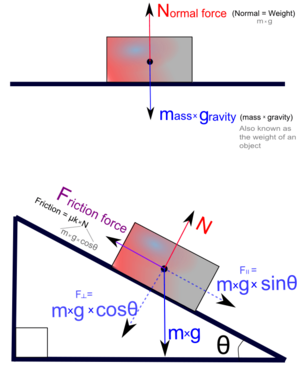Friction facts for kids
Friction is a force that slows things down when two surfaces rub against each other. Think of it like an invisible brake! When you slide a book across a table, friction is the force that makes it stop.
When two surfaces touch, tiny bumps on them get in the way of each other. This creates resistance, which we call friction. The energy lost to friction often turns into sound or heat. For example, rub your hands together quickly – they get warm!
There are two main types of friction:
- Static friction is when objects are not moving. It's the force that stops something from starting to move.
- Kinetic friction is when objects are already moving. It's the force that tries to slow them down.
Many things we use every day rely on friction, like car brakes, shoes, and even when you walk or write.
Contents
What Causes Friction?
Friction happens because of tiny bumps on surfaces called asperities. Even surfaces that look smooth have these tiny bumps.
- When two rough surfaces slide past each other, these asperities can get stuck. This makes it harder for the objects to move.
- To make the objects move, you need to apply enough force to break these tiny connections or slide over the bumps.
How Does Friction Work?
- When you push an object, static friction tries to stop it from moving. The harder you push, the stronger static friction becomes.
- But if you push hard enough, you overcome the static friction. Then the object starts to move and experiences kinetic friction.
- Kinetic friction is usually less than the maximum static friction. This is why it's often harder to start an object moving than to keep it moving.
Understanding the Coefficient of Friction
The coefficient of friction is a number that tells us how strong friction is between two surfaces.
- A higher coefficient means more friction. For example, rubber on concrete has a high coefficient, which is why car tires grip the road well.
- A lower coefficient means less friction. Ice skates on ice have a very low coefficient, which is why they glide easily.
Friction in Liquids and Gases
- When we talk about friction inside a liquid or gas, we call it viscosity.
- Viscosity describes how easily a fluid can flow.
- For example, honey is more viscous than water. It flows much slower because there's more internal friction within the honey itself.
How to Reduce Friction
Sometimes, we want to reduce friction to make things move more easily or efficiently. Here are some common ways:
Using Lubricants
- Lubricants are slippery substances like oil or grease. They create a thin layer between surfaces that are rubbing together.
- This thin layer stops the surfaces from touching directly, which greatly reduces friction.
- People have used lubricants for thousands of years! Ancient Egyptians used animal fats and oils as early as 3000 BC.
Designing for Streamlining
- Streamlining means designing objects to move through air or water with very little resistance.
- Think about the smooth shape of a fish or an airplane. Their shapes help them cut through the fluid (water or air) easily.
- This design principle is super important for fast vehicles like cars, planes, and boats.
Using Ball Bearings
- Ball bearings are small, hard balls that help reduce friction in rotating parts.
- Instead of surfaces sliding against each other, ball bearings allow them to roll. Rolling creates much less friction than sliding.
- Ball bearings have been used for a very long time, with early versions found from the 1st century AD.
Friction in Everyday Life
Friction is all around us and helps us do many things:
- Walking: Friction between your shoes and the ground stops you from slipping.
- Writing: Friction between your pen and the paper allows the ink to transfer and create words.
- Driving: Friction between car tires and the road helps the car move forward and turn.
- Braking: Friction in your car's brakes helps it slow down and stop safely.
- Playing Sports: Friction helps you grip a ball, swing a bat, or run without falling.
Related pages
Images for kids
See also
 In Spanish: Fricción para niños
In Spanish: Fricción para niños





